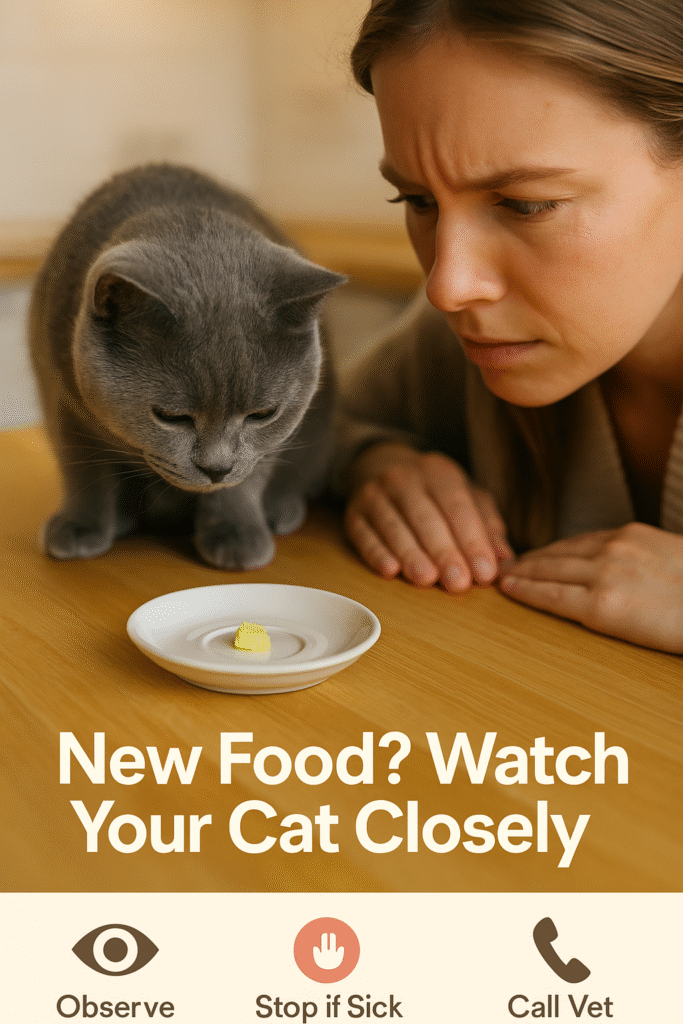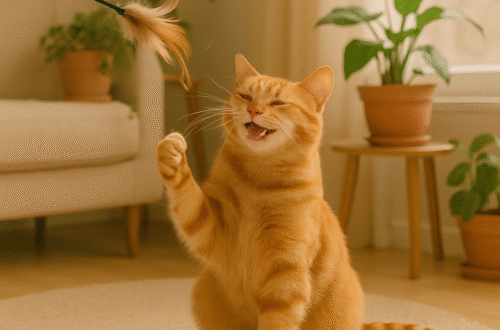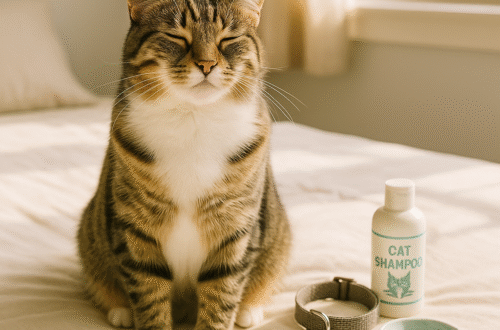If you’re a cat parent, you’ve likely been there sitting at the table, mid-bite, when your furry companion shoots you that look. You know the one: curious eyes, a gentle paw reaching out, and a meow that says, “Just one bite?” It’s tempting to share a piece of what’s on your plate, but is it safe?
While many human foods are harmful to cats, there are actually some surprising exceptions. From eggs to certain fruits and veggies, a few everyday foods can be offered as an occasional treat if you know what’s safe and how to serve it.

Why Most Human Food Is Dangerous for Cats (But Not All!)
Before we dive into the list of cat-safe foods, it’s important to understand why human food is usually off-limits.
Cats have a very different digestive system from humans. Many ingredients that are harmless (or even healthy) for us can cause serious issues for them from upset stomachs to long-term organ damage.
Here are some common human foods that are toxic to cats:
- Onions & Garlic – Even small amounts can damage red blood cells
- Chocolate – Contains theobromine, which is highly toxic to cats
- Grapes & Raisins – Can lead to kidney failure
- Alcohol & Caffeine – Extremely dangerous, even in tiny quantities
- Xylitol (found in sugar-free gum and some peanut butters) – Can cause rapid insulin release and liver failure
That’s why moderation is key and why it’s so important to know which foods are safe and how to serve them properly.
Rules of Feeding Human Food to Cats
So now you know some human foods can be safe but before you start sharing snacks with your cat, there are a few golden rules to follow.
These guidelines will help you avoid accidental harm and ensure your cat only gets the best from your plate.
1. No Seasoning, Spices, or Sauces
Cats don’t need salt, sugar, garlic, onions, or spices these can cause health issues. Always serve plain, unseasoned food.
2. Small Portions Only
Even safe foods should be served in tiny amounts. Think of them as treats not meals. Overfeeding can lead to obesity or digestive trouble.
3. Serve at a Safe Temperature
Avoid serving cold food straight from the fridge or piping hot items. Let everything come to room temperature to prevent shock or burns.
4. No Bones, Pits, or Peels
Remove any bones, fruit pits, seeds, or peels. These can be choking hazards or contain toxins.
5. One New Food at a Time
Introduce only one new food at a time. That way, if your cat reacts poorly, you’ll know exactly what caused it.

10 Human Foods That Are Safe for Cats (In Moderation)
1. Eggs
Why it’s safe: Eggs are packed with protein and essential amino acids that benefit your cat’s muscles and coat.
How to serve: Scrambled or boiled only plain, no salt, no oil.
Caution: Never give raw eggs (risk of salmonella or biotin deficiency).
2. Cooked Chicken
Why it’s safe: Lean, protein-rich, and something cats naturally love.
How to serve: Boiled or baked, skinless and boneless.
Caution: Avoid fried or seasoned chicken. No bones they can splinter.
3. Plain Cooked Rice
Why it’s safe: Gentle on the stomach and helpful for digestion.
How to serve: Soft, plain white or brown rice.
Caution: No butter, salt, or added ingredients.
4. Steamed Broccoli
Why it’s safe: High in fiber and antioxidants. Great for digestion.
How to serve: Lightly steamed, cut into tiny pieces.
Caution: Avoid raw broccoli; introduce slowly to avoid gas.
5. Canned Tuna (in Water)
Why it’s safe: Smells amazing to cats and offers protein + omega-3s.
How to serve: Occasional treat plain tuna in water, no oil or flavoring.
Caution: Too much can cause mercury buildup. Never make it a regular meal.
6. Banana
Why it’s safe: Contains potassium, fiber, and vitamins.
How to serve: A few soft, mashed bites as a rare treat.
Caution: High in sugar keep portions tiny.
7. Cooked Carrots
Why it’s safe: Great for vision and dental health when softened.
How to serve: Boiled or steamed until soft, chopped small.
Caution: Raw carrots are too hard and could be a choking hazard.
8. Cheese
Why it’s safe: Many cats enjoy it; it’s high in protein and calcium.
How to serve: Small cube of hard cheese like cheddar or gouda.
Caution: Many cats are lactose intolerant watch for digestive issues.
9. Watermelon
Why it’s safe: Mostly water — helps hydration, especially in summer.
How to serve: Seedless, rind removed, small chunks.
Caution: Too much sugar. Limit to hot days or as a rare treat.
10. Peanut Butter (Xylitol-Free Only)
Why it’s safe: Protein-packed and cats often love the taste.
How to serve: Just a tiny lick make sure it’s xylitol-free.
Caution: Xylitol is deadly for cats. Always read the label first.
Warning Signs to Watch After Feeding Your Cat Human Food
Even with safe foods, every cat is different. What works well for one might not sit right with another. That’s why it’s important to observe your cat closely after offering anything new.
Here are a few warning signs to watch for within the first 24 hours:
Common Reactions That Signal a Problem:
- Vomiting or Diarrhea – The most common signs of food intolerance
- Lethargy – If your cat seems unusually tired or sluggish
- Excessive Scratching or Skin Irritation – Could point to an allergic response
- Changes in Appetite or Water Intake – Eating or drinking less than usual
- Trouble Breathing or Swelling (Rare) – May indicate a serious allergic reaction
If you notice any of the above, stop feeding that item immediately and contact your vet especially if symptoms persist or worsen.
Play It Safe With These Tips:
Try one new food at a time, so you can track how your cat responds.
Wait a day or two before trying another new item.
Start with tiny amounts think 1/4 teaspoon or less.

How Often Can I Feed My Cat These Foods?
While it might be fun to let your cat sample your snacks, human food should always be treated as an occasional treat, not a regular part of their diet.
Here’s how to keep things balanced:
The “Occasional Treat” Rule:
- 1–2 times per week max for any safe human food
- Tiny portions only about the size of a fingernail
- Choose 1 type of food per day, not a mix
Best Use Cases:
- To hide medication (like peanut butter or cheese — vet-approved only)
- For enrichment or bonding during training or cuddle time
- As a healthy alternative to processed cat treats, but less often
Cats Still Need a Species-Appropriate Diet:
Remember: Cats are obligate carnivores they rely on animal protein and certain amino acids (like taurine) that are not found in fruits or veggies. Human food should never replace a complete, balanced cat food diet.





